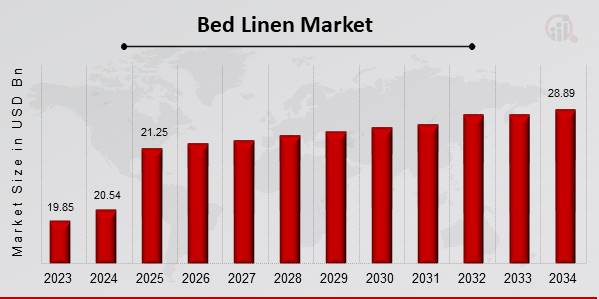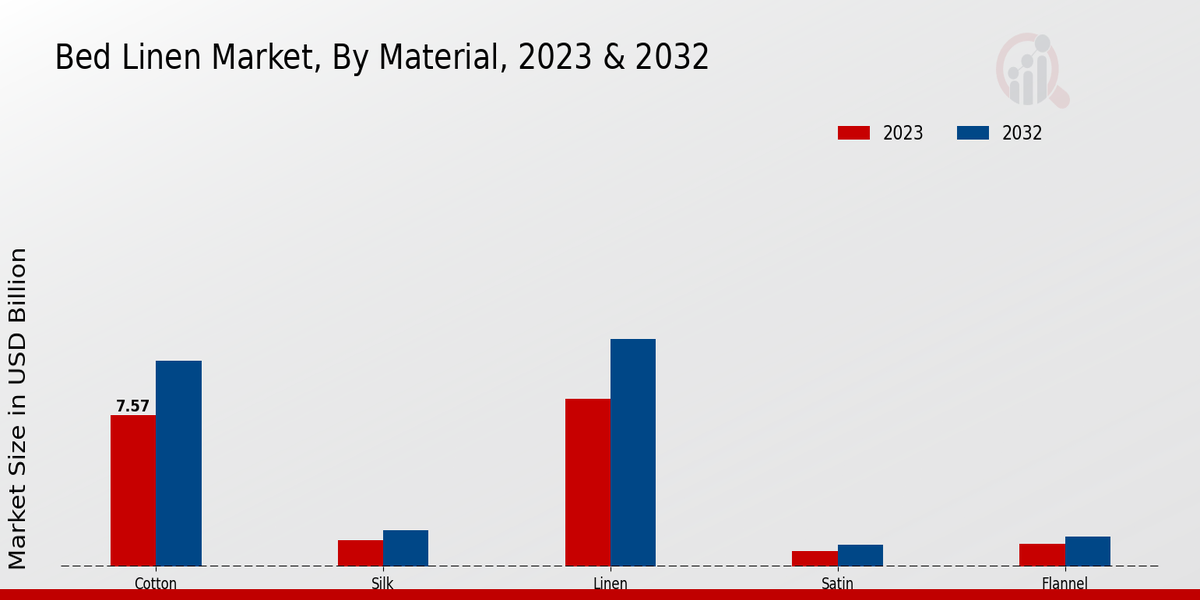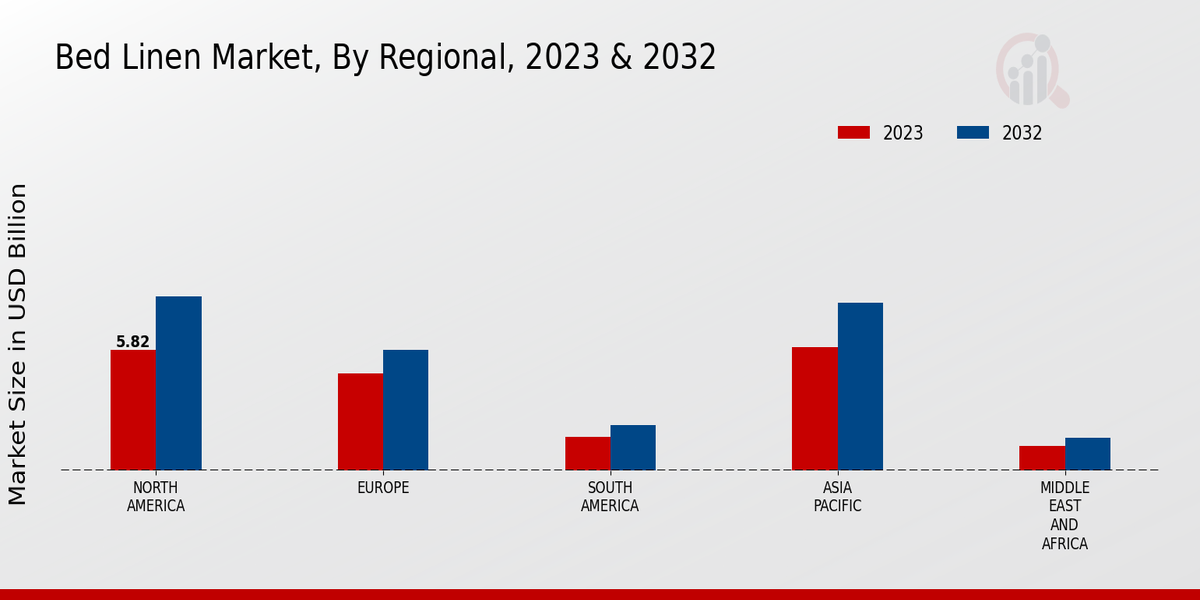Global Bed Linen Market Overview
Bed Linen Market Size was estimated at 20.54 (USD Billion) in 2024.The Bed Linen Market Industry is expected to grow from 21.25 (USD Billion) in 2025 to 28.89 (USD Billion) by 2034. The Bed Linen Market CAGR (growth rate) is expected to be around 3.5% during the forecast period (2025 - 2034).

Source: Primary Research, Secondary Research, MRFR Database and Analyst Review
Key Bed Linen Market Trends Highlighted
Key market drivers for the Bed Linen Market include rising disposable incomes, increasing urbanization, and growing awareness of home decor and comfort. The surge in demand for luxury and premium bedding products, driven by the desire for a comfortable and stylish sleeping experience, is also propelling market growth. Additionally, technological advancements in fabric production, such as the development of moisture-wicking and temperature-regulating fabrics, are catering to the evolving consumer needs.
Opportunities to be explored in the bed linen market lie in the expansion of e-commerce platforms, offering consumers convenient access to a wide range of products. The growing popularity of sustainable and eco-friendly practices presents opportunities for manufacturers to develop and market environmentally conscious bed linen products. Furthermore, the increasing demand for personalized and customized bedding solutions catering to individual preferences and tastes creates opportunities for tailored offerings.
Recent trends in the bed linen market include the rise of smart bedding products, incorporating technology for enhanced comfort and sleep quality. The integration of sensors and connectivity features allows for personalized sleep tracking, temperature regulation, and even sleep optimization. Additionally, the trend towards home automation and smart homes is driving the demand for smart bedding products that can be seamlessly integrated into smart home ecosystems.
Bed Linen Market Drivers
Rising Disposable Income and Changing Lifestyles
Increasing disposable income and evolving lifestyles have played a significant role in driving the growth of the Bed Linen Market Industry. As consumers become more affluent, they are willing to spend more on home furnishings, including bed linens. Additionally, changing lifestyles have led to a greater emphasis on comfort, aesthetics, and personalization in the bedroom, which has further fueled the demand for premium bed linens. The rising popularity of online shopping and the convenience it offers have also contributed to the growth of the market, as consumers now have access to a wider range of bed linens from different brands and retailers.
Growing Hospitality Sector
The growth of the hospitality sector has been another key driver of the Bed Linen Market Industry. Hotels, resorts, and other hospitality establishments require a substantial amount of bed linens to cater to their guests. The increasing number of hotel chains and the expansion of the tourism industry have led to a surge in the demand for high-quality and durable bed linens. Hotels and resorts often prefer to purchase bed linens in bulk from manufacturers or suppliers who can provide customized solutions to meet their specific requirements.
Technological Advancements and Product Innovations
Technological advancements and product innovations have also played a vital role in shaping the Bed Linen Market Industry. The introduction of new materials and technologies has led to the development of bed linens that are more comfortable, durable, and aesthetically appealing. For instance, the use of moisture-wicking fabrics, temperature-regulating materials, and anti-allergy treatments has enhanced the functionality and comfort of bed linens.Additionally, the adoption of digital printing techniques has enabled manufacturers to create bed linens with intricate designs and patterns, catering to the evolving preferences of consumers.
Bed Linen Market Segment Insights
Bed Linen Market Material Insights
The Bed Linen Market is expected to experience significant growth in the coming years, driven by factors such as rising disposable income, increasing urbanization, and growing awareness of home décor. The market is segmented based on material, with cotton, silk, linen, satin, and flannel being the most popular materials used in bed linen. Among these materials, cotton holds the largest market share due to its affordability, breathability, and comfort. Cotton is a natural fiber that is soft, absorbent, and durable, making it an ideal choice for bed sheets, pillowcases, and comforters.The global cotton bed linen market was valued at USD 7.45 billion in 2023 and is projected to reach USD 9.12 billion by 2032, exhibiting a CAGR of 2.7%. Silk is another popular material used in bed linen, known for its luxurious feel and elegant appearance. Silk is a natural protein fiber that is smooth, shiny, and hypoallergenic, making it suitable for people with sensitive skin. The global silk bed linen market was valued at USD 2.18 billion in 2023 and is expected to grow at a CAGR of 3.2% to reach USD 2.73 billion by 2032. Linen is a natural fiber that is derived from the flax plant.It is known for its durability, breathability, and moisture-wicking properties. Linen bed linen is often used in warm climates as it helps regulate body temperature. The global linen bed linen market was valued at USD 1.56 billion in 2023 and is projected to reach USD 1.95 billion by 2032, growing at a CAGR of 2.5%. Satin is a type of fabric that is woven with a high thread count, giving it a smooth, lustrous appearance. Satin bed linen is known for its luxurious feel and elegant look. The global satin bed linen market was valued at USD 1.89 billion in 2023 and is expected to reach USD 2.38 billion by 2032, exhibiting a CAGR of 2.6%.Flannel is a soft, napped fabric that is typically made from cotton or wool. Flannel bed linen is warm and comfortable, making it ideal for cold climates. The global flannel bed linen market was valued at USD 1.23 billion in 2023 and is projected to grow at a CAGR of 2.4% to reach USD 1.54 billion by 2032. The choice of material for bed linen depends on personal preferences, climate, and budget. Cotton is the most affordable and versatile option, while silk is the most luxurious and expensive. Linen is a durable and breathable choice, while satin is known for its smooth and elegant appearance.Flannel is warm and comfortable, making it suitable for cold climates.

Source: Primary Research, Secondary Research, MRFR Database and Analyst Review
Bed Linen Market Thread Count Insights
The thread count of bed linens is a key factor that influences their quality and feel. Higher thread counts generally indicate softer, more luxurious linens.
Linens with a thread count of 200 are considered entry-level and are often made from lower-quality materials. They are less durable and comfortable compared to higher thread count linens. 400 Thread Count: Linens with a thread count of 400 offers a balance between affordability and comfort. They are softer and more durable than 200-thread count linens, making them a popular choice for everyday use.
Linens with a thread count of 600 are considered mid-range and offer a noticeably softer and more luxurious feel compared to lower thread counts. They are also more durable and wrinkle-resistant.
Linens with a thread count of 800 are considered high-end and offer exceptional softness, smoothness, and durability. They are often made from high-quality materials like Egyptian cotton or Supima cotton.
Linens with a thread count of 1000 or higher are considered luxury linens and offer the ultimate in softness, comfort, and durability. They are often made from the finest materials and are designed to last for many years. The Bed Linen Market revenue is expected to grow significantly in the coming years, driven by increasing consumer demand for high-quality and comfortable bedding. The market growth is also supported by the rising popularity of online retailers, which offer a wide range of bed linens at competitive prices.
Bed Linen Market Size Insights
The Bed Linen Market segmentation by size offers insights into the market share and growth prospects of different bed linen sizes. In 2023, the twin-size segment accounted for a significant portion of the market, generating revenue of around USD 3.4 billion.
The Full-size segment followed closely, with a revenue of approximately USD 2.9 billion. The increasing popularity of smaller living spaces, particularly in urban areas, is driving the demand for Twin and Full-size bed linens. On the other hand, the Queen and King size segments are expected to witness steady growth, supported by the rising preference for larger and more comfortable sleeping arrangements.The California King size segment holds a smaller market share but caters to a niche segment of consumers seeking extra-large bed linens.
Bed Linen Market Pattern Insights
The Bed Linen Market revenue is segmented based on Pattern into Solid, Printed, Embroidered, Jacquard, and Quilted. The Printed pattern segment is estimated to hold the largest share of the market in 2023 and is projected to continue its dominance throughout the forecast period. The increasing preference for aesthetically appealing and vibrant bed linens among consumers is driving the growth of this segment. Printed bed linens offer a wide range of designs, colors, and patterns, allowing consumers to personalize their bedrooms and create a desired ambiance.Embroidered and Jacquard patterns are also gaining popularity due to their intricate designs and luxurious appeal. Quilted bed linens, known for their warmth and comfort, are expected to witness steady growth over the forecast period. Overall, the segmentation of the Bed Linen Market based on Pattern provides insights into the diverse preferences and demands of consumers, enabling manufacturers to cater to the evolving needs of the market.
Bed Linen Market Regional Insights
Regionally, North America held the largest revenue share in 2023, accounting for over 35% of the global market. The region's strong economic growth, coupled with rising consumer spending on home décor and luxury bedding products, has contributed to its dominance.
Europe is another significant market, holding a considerable revenue share and is expected to witness steady growth over the forecast period. The growing popularity of eco-friendly and sustainable bedding products, along with the presence of major industry players, is driving market expansion in Europe.

Source: Primary Research, Secondary Research, MRFR Database and Analyst Review
Bed Linen Market Key Players And Competitive Insights
The Bed Linen Market industry presents a landscape of prominent players shaping its competitive dynamics. Major players in the Bed Linen Market include globally established brands alongside regional players. These leading Bed Linen Market players engage in strategic initiatives such as product innovation, expansion of distribution channels, and mergers & acquisitions to gain market share and maintain their competitive edge.
The Bed Linen Market development is influenced by various factors, including changing consumer preferences, technological advancements, and the emergence of e-commerce platforms. The competitive landscape of the Bed Linen Market industry is expected to remain dynamic in the coming years, with existing players continuing to invest in growth strategies and new entrants seeking to capitalize on market opportunities.Among the leading Bed Linen Market players is Welspun India Ltd., a global home textiles manufacturer with a strong presence in the bed linen segment. The company offers a wide range of bed linen products, including sheets, pillowcases, and comforters, and has established a reputation for quality and innovation. Welspun India Ltd. has a global presence, with manufacturing facilities in India, the United States, and Europe, and its products are sold in over 50 countries. The company's commitment to sustainability and ethical practices further enhances its competitive position in the Bed Linen Market industry.Another prominent player in the Bed Linen Market is Sheridan, an Australian home textile brand known for its premium quality and luxurious designs. Sheridan offers a wide range of bed linen products, including sheets, duvet covers, and pillows, and is renowned for its use of fine fabrics and craftsmanship. The company has a presence in Australia and New Zealand and is expanding its international reach, with a growing presence in Asia and the Middle East. Sheridan's focus on innovation and customer satisfaction has helped it maintain a loyal customer base and a strong reputation in the Bed Linen Market industry.
Key Companies in the Bed Linen Market Include
- Anichini
- Welspun India
- Sheridan
- The Company Store
- Sferra
- Frette
- Peacock Alley
- Libeco
- Yves Delorme
- Pratesi
- Matteo
- Porthault
- Fazzini Home
- Esteem Industries
- Westpoint Home
Bed Linen Market Industry Developments
The Bed Linen Market is projected to grow from USD 19.19 billion in 2023 to USD 26.07 billion by 2032, exhibiting a CAGR of 3.47% during the forecast period. The market expansion is attributed to the rising demand for luxurious bedding, growing urbanization, and increasing disposable income in developing economies. The proliferation of e-commerce channels and the emergence of new market players are further bolstering market growth.
Technological advancements, such as the integration of smart features into bed linens, are also driving innovation and expanding market opportunities. Prominent manufacturers are focusing on sustainability initiatives, using eco-friendly materials and adopting ethical production practices to meet consumer demand for environmentally responsible products.
Bed Linen Market Segmentation Insights
Bed Linen Market Material Outlook
- Cotton
- Silk
- Linen
- Satin
- Flannel
Bed Linen Market Thread Count Outlook
- 200 Thread Count
- 400 Thread Count
- 600 Thread Count
- 800 Thread Count
- 1000+ Thread Count
Bed Linen Market Size Outlook
- Twin
- Full
- Queen
- King
- California King
Bed Linen Market Pattern Outlook
- Solid
- Printed
- Embroidered
- Jacquard
- Quilted
Bed Linen Market Regional Outlook
- North America
- Europe
- South America
- Asia Pacific
- Middle East and Africa
| Report Attribute/Metric |
Details |
| Market Size 2024 |
20.54 (USD Billion) |
| Market Size 2025 |
21.25 (USD Billion) |
| Market Size 2034 |
18.89 (USD Billion) |
| Compound Annual Growth Rate (CAGR) |
3.5% (2025 - 2034) |
| Report Coverage |
Revenue Forecast, Competitive Landscape, Growth Factors, and Trends |
| Base Year |
2024 |
| Market Forecast Period |
2025 - 2034 |
| Historical Data |
2019 - 2023 |
| Market Forecast Units |
USD Billion |
| Key Companies Profiled |
Anichini, Welspun India, Sheridan, The Company Store, Sferra, Frette, Peacock Alley, Libeco, Yves Delorme, Pratesi, Matteo, D. Porthault, Fazzini Home, Esteem Industries, Westpoint Home |
| Segments Covered |
Material, Thread Count, Size, Pattern, Regional |
| Key Market Opportunities |
Ecommerce Expansion Growing demand for luxury linens Increasing urbanization Health and wellness trend Sustainability concerns |
| Key Market Dynamics |
Growing demand for luxury bedding Increased consumer awareness of health benefits Surge in online bedding sales Rising disposable income in emerging economies Technological advancements in fabric production |
| Countries Covered |
North America, Europe, APAC, South America, MEA |
Frequently Asked Questions (FAQ) :
The Bed Linen Market is projected to reach a valuation of 28.89 billion USD by 2034, exhibiting a CAGR of 3.5% from 2025 to 2034.
North America holds a significant market share, driven by rising consumer awareness and rising demand for home furnishing products in the region.
The growth of the bed linen market is primarily attributed to factors such as increasing urbanization, rising disposable income, and growing awareness about home décor and comfort.
Cotton is the most widely used fabric in bed linen products due to its breathability, comfort, and durability.
Bed linen products are primarily used in residential and commercial settings, including bedrooms, hotels, hospitals, and guesthouses.
Some of the key competitors in the Bed Linen Market include Bed Bath & Beyond, IKEA, Walmart, Amazon, and Macy's.
The Bed Linen Market is expected to grow at a steady CAGR of 3.5% during the forecast period of 2025-2034.
Online retail channels have emerged as a significant distribution channel for bed linen products, offering convenience and a wide selection to consumers.
The Bed Linen Market is witnessing trends such as increasing demand for sustainable and eco-friendly products, growing popularity of smart bed linens with integrated technology, and rising adoption of home automation systems.
The COVID-19 pandemic led to a temporary decline in bed linen sales due to disruptions in supply chains and reduced consumer spending. However, the market is expected to rebound as economic activities resume and consumer confidence improves.

















